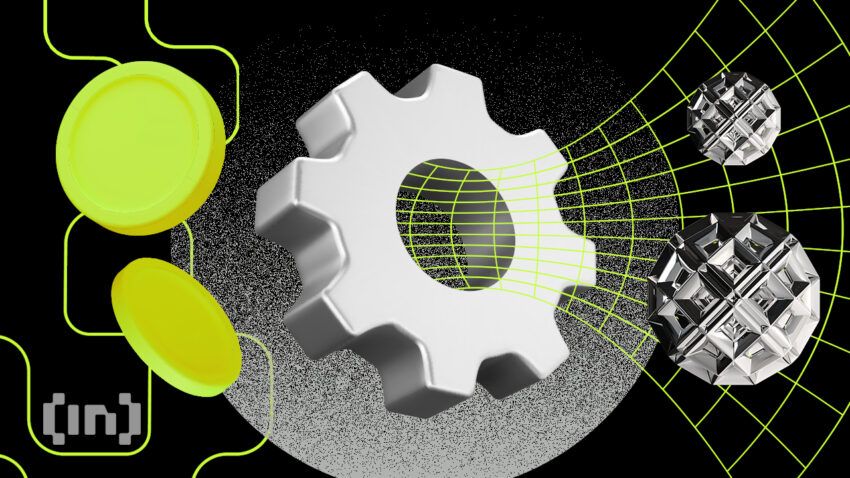Web3 technology is revolutionizing the internet as we know it, offering a decentralized and transparent way of operating online. With the rise of blockchain-based applications, the need for an efficient and reliable web3 infrastructure plays an ever more vital part in the success of a project. However, deploying blockchain infrastructure comes with its own set of challenges. These range from technical complexities to regulatory hurdles.
This guide explores the challenges of deploying web3 infrastructure and discusses potential solutions to overcome these obstacles. Whether you are a developer, an investor, or simply interested in the future of the internet, this article will provide valuable insights into the challenges and opportunities of the web3 revolution.
BeInCrypto Trading Community in Telegram: read the hottest news on web3, get technical analysis on cryptocurrency & answers to all your questions from PRO traders & experts!
- Blockchain infrastructure in a nutshell
- The nodes that make a blockchain network
- The nodes that secure the network and those that don’t
- Solving real-world use cases one block at a time
- Identifying blockchain infrastructure pitfalls early
- Dodging deployment pitfalls in blockchain infrastructure
- Getting blockchain infrastructure right is key for web3 success
- Frequently asked questions
- About the author
Blockchain infrastructure in a nutshell

Blockchain infrastructure refers to the various nodes that make up a blockchain network. In a blockchain network, a node is essentially a participant that can interact with the network by running the specific blockchain client.
While, in some cases, nodes can be run on personal computers or even small devices like Raspberry Pis, the complexity and size of many blockchain networks often require the use of dedicated servers. Often, these servers are maintained by individuals with sufficient technical knowledge and resources necessary to support the network’s healthy operations.
This network of interconnected nodes allows data to be accessed and shared without relying on a centralized server. In turn, this creates a decentralized and resilient infrastructure that underpins the blockchain’s unique properties and offers you a comprehensive overview of the scope behind the terminology.
The nodes that make a blockchain network
Essentially, blockchain nodes can be classified by two primary modes: full and light. The main distinction lies in their storage capabilities. Full nodes maintain a complete record of the blockchain’s history. Meanwhile, light nodes download only block headers to conserve hard drive space for their users.
More often than not, you will just be faced with three main modes. Let’s delve deeper into the particulars of each:
Full nodes
Full nodes are responsible for storing the entire blockchain and ensuring the validity of transactions. To sync, a full node downloads all blocks from the genesis block. These include headers, transactions, and receipts. Then, the full node painstakingly verifies every block and re-executes each transaction. These powerful nodes form the backbone of the network. This provides crucial security and ensures that only valid transactions make their way onto the chain.
While a full node can be used to retrieve information about the state of the blockchain, it’s important to maintain efficiency by periodically pruning (removing) some data. On most EVM-compatible blockchains, for example, a full node can only query the blockchain state up to the last 128 blocks. It’s technically possible to reconstruct all intermediate states from the genesis block. Yet doing so would be an incredibly resource-intensive Herculean task. It could cause the node to fall out of sync, potentially disabling it altogether.
Archive nodes
A full node typically prunes data to save precious disk space. However, in the event you need to access historical data, it’s possible to run a full node in archive mode. When running in this mode, the node stores all intermediate states. This gives you the ability to query information from any point in the past. These modes of nodes are used by DeFi projects in order to show historical price charts or analytics projects, like Dune Analytics, in order to provide historical data to its users or for indexing infrastructure projects like The Graph.
While archive mode is a powerful tool, it comes at a significant cost in terms of resources. Depending on the blockchain, syncing an archive node can take months, making it the least desirable option for many users. Still, for those who need access to every detail of the blockchain’s past, access to an archive node might be essential.
Light nodes
Not everyone can access a server farm or a data center. That’s where light nodes come in. They provide a way for individuals to participate in the network without the need for powerful hardware or expensive infrastructure. However, light nodes don’t participate in the consensus process and aren’t eligible to act as validators.
When syncing with the network, a light node takes a different approach than a full node. Rather than downloading all the data, a light node downloads only the block headers, which contain a summary of the block’s content. To ensure the integrity of the data, the light node will randomly verify some of the block headers. Then it will rely on full nodes to retrieve the rest of the data.
For this system to work, full node operators must activate the light server option to allow light nodes to query information.
The nodes that secure the network and those that don’t
As blockchain technology developed over the years, new concepts steadily made their way into the mainstream’s consciousness. Nodes were not among those that skipped the bandwagon either. That is why, apart from the three main modes mentioned above, there’s another division between the validator and non-validator nodes.
Differences between validator and non-validator nodes
A validator node, as the name implies, is a node that is responsible for validating blocks of transactions before adding them to the blockchain ledger. In layman’s terms, this means that validator nodes take the key role of delivering pretty much everything that defines a blockchain network.
Depending on the blockchain’s consensus mechanism, you can have miners in the case of proof-of-work (PoW) blockchains like Bitcoin and validators in the case of proof-of-stake (PoS) blockchains like Ethereum. In any case, the role of miners and validators is the same. This is to enforce the consensus mechanism of a certain protocol and validate transactions before adding them to the blockchain.
In a network, you also have non-validator nodes. Non-validator nodes do not secure the network. However, they provide access to the network for all sorts of users and development purposes. You can use these nodes in order to access the network. This is where the light nodes mentioned earlier come into play. You get access to the network through them, but they can not satisfy the role of a validator node because they do not take part in the consensus process.
If you are building a DApp, you do not need a validator node for it. Access to the network through a non-validator node will be enough to deploy smart contracts, test, and interact with other network participants.
So, now that you know the ins and outs of the nodes you need to make your next project a stunning success, let’s take a closer look at how you can apply them beyond a local sandbox and reap their rewards.
Solving real-world use cases one block at a time

Blockchain technology and web3 infrastructure have rapidly emerged as a game-changing technology, enabling businesses to implement affordable, secure, and faster transactional systems and applications. By leveraging blockchain technology, businesses can build tamper-proof systems and streamline processes, resulting in faster and more efficient operations. For example:
Automation
You can eliminate human errors by automating your processes through smart contracts. You will reduce the number of errors that occur, increase the speed, and reduce your costs through automation.
An example is how Walmart leverages blockchain tech to create an automated process for handling invoices and payments of its 70 third-party freight carriers. According to this study, the grocery/retail giant reduced their invoice data discrepancy from 70% to 1% with the help of blockchain.
Trust & transparency
Blockchain networks are open. Everyone can see the account balances of every address on the network. So how can this transparency be used in a real-world example?
Let’s say that you are an exchange company. You can use blockchain networks to show proof of reserves and show your users, stakeholders, shareholders, and other three parties that you have the funds necessary to do everyday business. This will increase trust in your company. Users will know their funds are safe and will keep using your services.
Security
Permissionless public blockchains are very secure because of their decentralized nature. They do not have a single point of failure, which makes them robust. But security does not stop there.
You can create your own permissioned protocol using an enterprise solution like Corda or Quorum. You can create your own network, inviting only other participants you trust (these can be your business partners), and you can register users based on IDs.
In doing so, you make sure that only people you know and trust can access your network, and you can do business together. If you are an auto manufacturer, you can give access to this network to your logistics partners. Now you have a secured synced database that you can track in real-time.
But it’s not all green pastures and roses. Quite the contrary — although all the wonderful boons blockchain networks can bring to the table for a business, there are still some game-breaking challenges to resolve when deploying. Let’s walk through some of those that have become a given.
Identifying blockchain infrastructure pitfalls early

Keeping even a single node synchronized and running smoothly can be a challenge. All these woes start at ground zero, as it often takes an unreasonable amount of time and effort to get up and running. Depending on the hardware and network you are using for your operations, reaching a fully-synced state can take anywhere from several hours with a good setup and a small ledger to days and weeks for power-hungry giants like Ethereum for storage or Solana for compute resources.
Keeping nodes fully synced
But the hard times don’t stop there; quite the contrary. You then have to face the uphill battle of keeping your node fully synced. And this is tougher than it sounds. Desync happens quite often for arbitrary reasons you can do little to mitigate. This can steal an outrageous amount of time you would’ve otherwise spent building your DApp or generating value with it.
The most ironic part is that all of this applies to a setup with a single on-premise node only and not a number of them working in tandem. Naturally, should you desire for your DApp to get even the slightest hint of a mainnet experience, there is little you can do than to expand your operation in order to scale. But even if this sounds exciting and fun, that will hardly be the case for whoever is responsible for maintaining it all — likely yourself.
The more nodes you have as part of your on-premise setup, the more the issues you had with one can multiply and scale with the complexity of your infrastructure configuration. Even a single node going dark and desyncing can cause a resonance cascade of exceptions, bringing your project to a grinding halt.
And worse yet, circumstances mostly outside of your control, like heavy network load or even a poorly optimized software patch, may knock on your door when they are least welcome. Such issues can build up and create a breaking point, as it all comes crumbling down like a house of cards.
Node locations
Another common issue is the location of your node. For example, you have a DApp running and a fully synced node running and maintained in Europe. Then you have a surge of users in Asia who will have to access your DApp’s data through your node in Europe and will be immediately at a UX disadvantage (latency) compared to the users in Europe. If it weren’t for node providers, your only option would be to start up a node on a server in Asia and wait for weeks for it to sync. With node providers, you can fix this issue within minutes. You can pick the location in which you want to deploy your node.
Dodging deployment pitfalls in blockchain infrastructure
The circumstances mentioned above will sooner or later put you in the situation of a driver whose car has broken down in the middle of nowhere. So what do you do? Who are you gonna call? Here’s a hint – it definitely won’t be a team of paranormal investigators living in the 80s.
If you’re looking to deploy nodes quickly and easily without worrying about pesky exceptions and desynchronization issues, consider opting in for the services of a blockchain node provider. Thanks to the robust and powerful hardware these providers have under the hood, getting a node up and running from scratch takes significantly less time and effort — often a matter of mere minutes.
How blockchain node providers can help
Instead of fighting every fire as it emerges, blockchain node providers can lift this burden off your shoulders and pass issues to a dedicated team of engineers. And like the lightning-fast deployments offered by an often patented piece of tech like Bolt, having a team of professionals maintain your infrastructure can be a godsend. Above anything else, it will remove stress away from you and leave you with more precious time to dedicate to building and generating value with your project.
Time is money, but so are the significant investments that effective on-premise infrastructure requires. In contrast, opting for a node provider subscription plan requires a much more affordable commitment, with zero-cost options available too. Because of this, your operational expenditures will have a lesser impact on your bottom line.
Getting blockchain infrastructure right is key for web3 success
Web3 infrastructure is not just a cool and exciting piece of tech but one that is also fraught with challenges at every level. Issues such as latency, scalability, and interoperability are important for builders to consider, especially when deploying on-premises.
It’s not all doom and gloom, however, as some trusted parties can take care of all the heavy lifting for you. By leveraging blockchain node providers’ powerful hardware and infrastructure setups, you can significantly cut down on time-to-market and operational expenditures. In handing over the responsibility for the unwieldy maintenance process, you can focus on building exceptional web3 experiences.
Frequently asked questions
What is blockchain infrastructure?
What are the main modes of blockchain nodes?
What are validator and non-validator nodes?
What are the main challenges of deploying your infrastructure?
About the author
Juan Oliva is a marketing professional with an entrepreneurial background and significant web3 exposure. He is currently leading Marketing at Chainstack, the leading suite of services connecting developers with web3 infrastructure. Juan has been actively involved in the crypto space since 2015. He has invested in and run a six-figure Ethereum mining operation for several years, run nodes, and made strategic investments in virtual real estate, among other things.
Juan continues to stay at the forefront of the crypto and web3 industry, regularly interacting with different protocols, investing in new projects, and actively using multiple protocols and projects.
Disclaimer
In line with the Trust Project guidelines, the educational content on this website is offered in good faith and for general information purposes only. BeInCrypto prioritizes providing high-quality information, taking the time to research and create informative content for readers. While partners may reward the company with commissions for placements in articles, these commissions do not influence the unbiased, honest, and helpful content creation process. Any action taken by the reader based on this information is strictly at their own risk. Please note that our Terms and Conditions, Privacy Policy, and Disclaimers have been updated.




